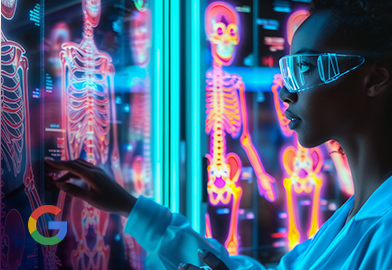Digital Production
Google Health Check Up 2024: How Google is Paving the Way for AI-Assisted Healthcare
Igor Vianna - Our Managing Director


Google Health Check Up 2024: How Google is Paving the Way for AI-Assisted Healthcare
Google Health is Google’s division that represents the company’s ambitious venture into healthcare transformation, uniting its vast technological capabilities with healthcare expertise to develop innovative solutions for patients, providers, and researchers worldwide. As a dedicated team, it leverages Google’s capabilities in artificial intelligence, machine learning, and data analytics to address critical healthcare challenges, from improving disease detection to streamlining clinical workflows and enhancing access to care.
Since 2021, the Google Health team has hosted its annual Check Up event, which has become an important platform for showcasing the company’s latest healthcare innovations and establishing its growing influence in the medical technology sector. This yearly event is used as a stage to announce groundbreaking developments in AI-powered healthcare tools, demonstrate new features in existing medical technologies, and share updates on ongoing research initiatives. In this article, the C/Edge team has selected some of the most significant advancements presented by the Google Health team at Google Health’s Check Up 2024:
Understanding MedLM and Its Impact on Healthcare
Imagine having a super-smart medical assistant that can understand everything from your doctor’s notes to your X-rays – that’s essentially what MedLM is: a medically tuned large language model (LLM) developed to enhance healthcare services across several areas. It works by processing and understanding medical information from diverse sources such as patient records, clinician notes, and even video consultations. MedLM can then provide insights and generate human-quality text, like detailed medical reports or summaries, improving communication between patients, caregivers, and clinicians.
What makes MedLM special is that it doesn’t just focus on one type of medical data. Instead, it can handle multiple types of information simultaneously – from written notes to images and videos. This capability, technically known as multimodality, mirrors how healthcare professionals actually work in real life: considering all available sources and types of information before making decisions about patient care.
A Closer Look at MedLM for Chest X-Rays
One particularly exciting application of this technology is MedLM for Chest X-rays. Think of it as a highly specialized assistant for radiologists. Instead of just looking at X-ray images in isolation, this system can analyze the images while also considering other relevant patient information. This comprehensive approach helps radiologists work more efficiently and accurately, especially when they’re dealing with large numbers of X-rays.
The real game-changer here is how it helps streamline the radiologist’s workflow. It can spot important findings, categorize them, and even help draft reports, all while maintaining high accuracy standards. This means radiologists can focus more on complex cases and patient care, rather than getting bogged down in routine tasks.
SCIN: Breaking New Ground in Dermatology
Anyone barely familiar with how Artificial Intelligence systems work understands that training any model takes a huge amount of data and that the final result is only as good as the input data. And here we are talking about not only the ‘quality’ of the data itself but also its variety: You can’t expect a model to generalize its learning to data patterns it has never seen before. Here’s where things get really interesting – and important. Another very interesting initiative presented by Google Health is the Skin Condition Image Network (SCIN), which is tackling a long-standing problem in dermatology: the lack of diverse skin representation in medical datasets. It’s a comprehensive collection of thousands of images showing various skin, nail, and hair conditions across different skin tones and demographics.
What makes SCIN particularly valuable is its deliberate focus on inclusivity. Historically, dermatology databases have been limited in their representation of different skin tones, which has led to AI systems that work better for some people than others. SCIN changes this by providing a truly diverse dataset, carefully labeled by dermatologists using both the Fitzpatrick and Monk skin tone scales.
This isn’t just about having more pictures – it’s about creating fairer, more accurate diagnostic tools that work well for everyone, regardless of their skin tone. By training AI systems on this more representative dataset, we’re moving toward a future where everyone can receive equally accurate diagnoses and appropriate treatments for their skin conditions.
Following up with the advancements of the healthcare market solutions and the benefits they have to offer to both patients and healthcare professionals alike is not easy, but it’s something that we at C/Edge are passionate about. You can count on us to provide you and your company with up-to-date technology and the tools you need to thrive in the ever-changing landscape of healthcare marketing communication and digital production. Get in touch with us and let’s talk about how we can help you change the future of healthcare marketing today!
